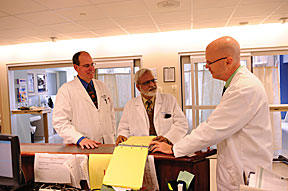Shooting. Throbbing. Sharp. Dull. Pounding. Tingling. Hot. Pain may be universal, but for each person it’s also a unique experience — one that’s tough to measure, with an endless list of possible causes and physical locations.
 |
| Anesthesiology Professor Mali Mathru, M.D., (center), trains residents David Miller, M.D., (left), and Richard Gist, M.D., (right), on the multidisciplinary team that manages all aspects of anesthesiology clinical care. |
New clinics and programs, innovative techniques and technologies are reshaping anesthesiology at UAB, especially the Regional Anesthesia Pain Service that began more than two years ago.
Regional anesthesia employs nerve blocks, or injections of local anesthetic, to numb specific areas of the body where a surgical incision will be made. And according to Jim Sparrow, M.D., medical director of the service, the number of blocks performed each month has increased to more than 200 from 45 in 2007. Today’s blocks that use an advanced ultrasound-guided technique are more precise than the traditional nerve-stimulation format.
Previously, anesthesiologists would administer a block using anatomic landmarks and specialized stimulating needles. Once near the nerve bundle to be blocked, the corresponding muscle would twitch to let them know where to deposit the local anesthetic.
“That’s not going completely blind because you’re near the nerve,” Sparrow says. “The problem is that you don’t know if you’re in the nerve.”
The new ultrasound-guided regional anesthesia enables doctors to visualize the nerve and needle on a monitor. They can see exactly where the injected anesthetic is going and ensure that the needle does not hit the nerve.
“Sometimes when you use the nerve-stimulation technique you get great twitches, but the local anesthetic would track back in a different way — not around the nerve — and we wouldn’t get a good block,” Sparrow says. “Since we received our two ultrasound machines, we’ve gone from all nerve-stimulation blocks to about 70-percent ultrasound-guided blocks. That’s a pretty significant shift in our practice, and it’s really enabled anesthesia to have a little bit of a renaissance.”
In addition, Sparrow says, approximately 80 percent of the blocks are performed preoperatively, which benefits patients in two key ways: They can be comfortable when they wake up from surgery, and they require a lesser amount of opioids during the procedure than patients who don’t receive preoperative blocks.
“The sheer amount of narcotics we no longer have to give is enormous, even in the recovery room, because when the patients are asleep, they don’t feel the area where the operation took place,” Sparrow says. “And when they wake up, they’re still comfortable. To see patients at ease and experiencing no pain in the recovery room provides a great sense of pride that we’re really helping people.”
Visit medicine.uab.edu/magazine/63664 to learn more about anesthesia services at UAB.